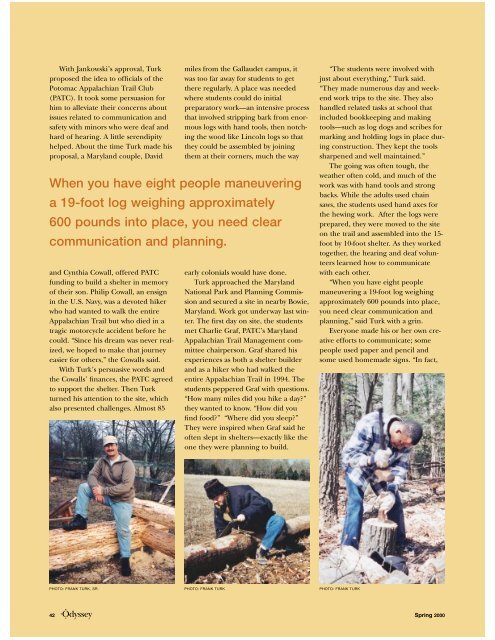Deaf ESL Students - Gallaudet University
Deaf ESL Students - Gallaudet University
Deaf ESL Students - Gallaudet University
Create successful ePaper yourself
Turn your PDF publications into a flip-book with our unique Google optimized e-Paper software.
With Jankowski’s approval, Turk<br />
proposed the idea to officials of the<br />
Potomac Appalachian Trail Club<br />
(PATC). It took some persuasion for<br />
him to alleviate their concerns about<br />
issues related to communication and<br />
safety with minors who were deaf and<br />
hard of hearing. A little serendipity<br />
helped. About the time Turk made his<br />
proposal, a Maryland couple, David<br />
and Cynthia Cowall, offered PATC<br />
funding to build a shelter in memory<br />
of their son. Philip Cowall, an ensign<br />
in the U.S. Navy, was a devoted hiker<br />
who had wanted to walk the entire<br />
Appalachian Trail but who died in a<br />
tragic motorcycle accident before he<br />
could. “Since his dream was never realized,<br />
we hoped to make that journey<br />
easier for others,” the Cowalls said.<br />
With Turk’s persuasive words and<br />
the Cowalls’ finances, the PATC agreed<br />
to support the shelter. Then Turk<br />
turned his attention to the site, which<br />
also presented challenges. Almost 85<br />
miles from the <strong>Gallaudet</strong> campus, it<br />
was too far away for students to get<br />
there regularly. A place was needed<br />
where students could do initial<br />
preparatory work—an intensive process<br />
that involved stripping bark from enormous<br />
logs with hand tools, then notching<br />
the wood like Lincoln logs so that<br />
they could be assembled by joining<br />
them at their corners, much the way<br />
When you have eight people maneuvering<br />
a 19-foot log weighing approximately<br />
600 pounds into place, you need clear<br />
communication and planning.<br />
early colonials would have done.<br />
Turk approached the Maryland<br />
National Park and Planning Commission<br />
and secured a site in nearby Bowie,<br />
Maryland. Work got underway last winter.<br />
The first day on site, the students<br />
met Charlie Graf, PATC’s Maryland<br />
Appalachian Trail Management committee<br />
chairperson. Graf shared his<br />
experiences as both a shelter builder<br />
and as a hiker who had walked the<br />
entire Appalachian Trail in 1994. The<br />
students peppered Graf with questions.<br />
“How many miles did you hike a day?”<br />
they wanted to know. “How did you<br />
find food?” “Where did you sleep?”<br />
They were inspired when Graf said he<br />
often slept in shelters—exactly like the<br />
one they were planning to build.<br />
PHOTO: FRANK TURK, SR. PHOTO: FRANK TURK PHOTO: FRANK TURK<br />
“The students were involved with<br />
just about everything,” Turk said.<br />
“They made numerous day and weekend<br />
work trips to the site. They also<br />
handled related tasks at school that<br />
included bookkeeping and making<br />
tools—such as log dogs and scribes for<br />
marking and holding logs in place during<br />
construction. They kept the tools<br />
sharpened and well maintained.”<br />
The going was often tough, the<br />
weather often cold, and much of the<br />
work was with hand tools and strong<br />
backs. While the adults used chain<br />
saws, the students used hand axes for<br />
the hewing work. After the logs were<br />
prepared, they were moved to the site<br />
on the trail and assembled into the 15foot<br />
by 10-foot shelter. As they worked<br />
together, the hearing and deaf volunteers<br />
learned how to communicate<br />
with each other.<br />
“When you have eight people<br />
maneuvering a 19-foot log weighing<br />
approximately 600 pounds into place,<br />
you need clear communication and<br />
planning,” said Turk with a grin.<br />
Everyone made his or her own creative<br />
efforts to communicate; some<br />
people used paper and pencil and<br />
some used homemade signs. “In fact,<br />
42 Spring 2000
















